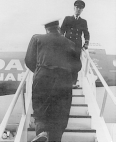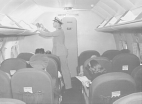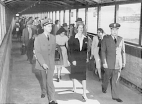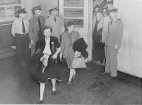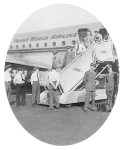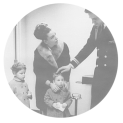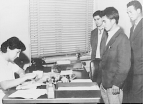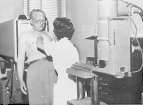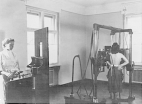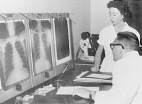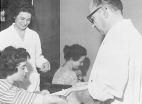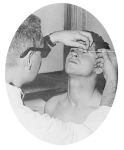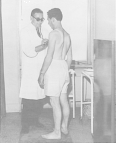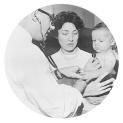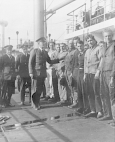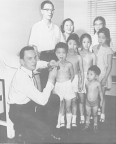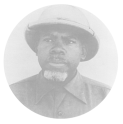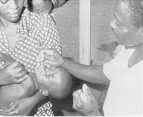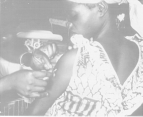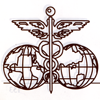 International Health
International Health
Participation by the Public Health Service in international activities was very limited until the latter part of the 19th century. The earliest international contacts were mainly on an individual basis, usually American physicians going to study at European universities and laboratories, which were then at the forefront of biomedical research and the sanitary sciences. Toward the end of the 19th century Public Health Service officers began traveling to international sanitary conferences, both abroad and in this country, in order to explore and develop conventions for preventing the spread of epidemic diseases and for implementing effective quarantine measures.
Public Health Service officers took an active pan in planning, creating, and directing the activities of several major international health organizations. such as the Pan American Sanitary Bureau, which was established in 1902; the International Office of Public Health, which was established in Paris in 1909; and the World Health Organization, which was created in 1948 and which eventually absorbed the other two organizations.
Since 1968 the John E. Fogarty International Center has been the primary focal point for coordinating NIH international activities by supporting biomedical research through international fellowships and scientist exchanges, and by providing assistance to the NIH in planning and implementing international research programs.
By means of its various computer data bases the National Library of Medicine provides a very valuable world-wide medical information service.
Gallery
The first person to board the arriving plane at Kennedy International Airport in New York City is a foreign quarantine inspector of the Public Health Service.
c. 1947
A foreign quarantine officer inspects the plane and sprays it with insecticide before allowing the passengers to disembark. Of particular concern was the spread of malaria and yellow fever by the importation of mosquitoes. The Public Health Service did important work in improving and standardizing insecticides for use on aircraft, and in developing methods of disinsectization.
c. 1947
Passengers arriving from Paris at LaGuardia Airport in New York City and walking through the walk-way, known as the "sheep run," to the quarantine room. They are led by inspection officers Evans and Weeks.
c. 1947
Passengers from London entering the quarantine room at LaGuardia Airport in New York City.
c. 1947
Passengers from Cairo, Egypt, Debarking at Kennedy International Airport in New York City with inspection officers Weeks and Evans in front. The number of aircraft inspections gradually increased from about 5,000 in 1930 to about 50,000 in 1950.
c. 1947
With the development of international aircraft travel, measures were instituted to prevent the introduction of diseased persons and disease-carrying insects and animals into the United States. This little boy had a recent case of chicken pox. Dr. Close, Medical Officer at Kennedy International Airport in New York City, takes a good look to make sure there are no signs of smallpox, a quarantinable disease in 1965.
c. 1965
Before 1921, many immigrants arrived at quarantine in the United States only to find they had an illness or physical defect which prevented them, by law, from entering the country. Sometimes a family was stranded without adequate funds to return to their former home. Examinations overseas prevented such hardships among visa applicants and simplified the administration of the United States immigration laws. The process begins at the Naples Foreign Quarantine Station with a series of questions concerning previous history of illness and accidents.
1959
Medical technical assistant Sara Maffezzoli at the Naples Foreign Quarantine Station prepares Osmanay Myslin, a 47-year-old refugee from Tirana, Albania, for a chest X-ray.
1959
A woman getting X-rayed for tuberculosis in a U.S. quarantine office in Berlin, Germany, to see if she is eligible for a visa to enter the United States.
c. 1959
Dr. Franco Ermenegildo and Miss Sara Maffezzoli read the X-ray films.
1959
A blood test for syphilis was done also for each applicant.
1959
Dr. Franco Ermenegildo at the Naples Foreign Quarantine Station examines the eyes of 23-year-old Francesco Rotundo from Catanzaro, Italy, for trachoma. The Public Health Service's Division of Foreign Quarantine maintained examination centers in such cities as Paris, London, Frankfort, Munich, Naples, Palermo, and Athens, with local physicians available for examinations through many United States consulates.
1959
At the Naples Foreign Quarantine Station Dr. Franco Ermenegildo examines the chest and heart of 27-year-old Ferdinando De Panlis from Bagno, Italy, who wants to emigrate to Hawthorne, New York. Besides the chest and heart, the physicians also tested the eyes and blood as well as mental health.
1959
At the Naples Foreign Quarantine Station Dr. Franco Ermenegildo examines 1-year-old Elias West from Athens, Greece, who was adopted by Mrs. Bobby West of Clarksville, Tennessee. In the center is Mrs. Emma Germano, visa examination aide. Every day in the week hundreds of would-be American citizens entered United States quarantine offices in Europe for medical examinations to determine whether they were eligible for visas to enter this country.
1959
The Public Health Service's Division of Foreign Quarantine was responsible for preventing the importation of disease into the United States. Abroad it relied heavily on the work of United States consular officers, who were required to notify the Surgeon General immediately of the appearance of any infectious or contagious disease in a foreign port, and to provide information regarding vessels from infected ports bound for the United States. At home the division's medical officers helped man quarantine stations in the major ports and inspected crews of cargo vessels from foreign ports, such as pictured here.
c. 1930
A Public Health Service medical officer at the United States consulate in Hong Kong is examining the family of Chang Kan Tai, whose members are applying for visas to the United States.
c. 1962
The Office of International Health Relations was established in 1943 under the authority of the Public Health Service Act of July 1, 1944. It was organized by its first director, Dr. James A. Doull, primarily to administer the overseas projects of the Service such as the Mission to Liberia and a growing fellowship training program. In 1948, Senior Surgeon Hildrus A. Poindexter (1901-1987) was appointed director of the Mission to Liberia, whose goal was to help the Liberian government in sanitation planning and the control of infectious diseases. Dr. Poindexter is pictured here on safari during a tsetse fly survey.
c. 1950
In addition to providing leadership and assistance in the prevention and control of disease in the United States, the Centers for Disease Control and Prevention in Atlanta, Georgia, work with international health and scientific organizations to improve the health of all people. Through the World Health Organization (WHO), the center's medical teams helped to eradicate smallpox from the countries of West Africa. Here a staff physician of the WHO vaccinates a youngster against smallpox by means of a jet injector.
c. 1970
Providing oral polio vaccine to children in Africa in order to reduce disability from poliomyelitis by 75 percent by 1991 is one of the target goals of the Combating Childhood Communicable Disease (CCCD) project in Africa. Initiated in 1981, CCCD is a joint effort of the Centers for Disease Control and Prevention, the U.S. Agency of International Development, and governments of participating countries. The primary objective is to reduce high infant and childhood mortality rates by treating young children and pregnant women.
c. 1982
Another 1991 target goal of the Combatting Childhood Communicable Diseases (CCCD) program in Africa is to immunize pregnant women with tetanus toxoid vaccine in order to reduce neonatal tetanus mortality by 25 percent. The more general goal is to increase immunization coverage of pregnant women to 60 percent. The emphasis of the CCCD program, which is a joint project with the Centers for Disease Control and Prevention and other government institutions, is on the application of 3 simple safe, effective, and economical technologies: immunization, oral rehydration therapy, and malaria treatment for children under the age of 5.
c. 1982



